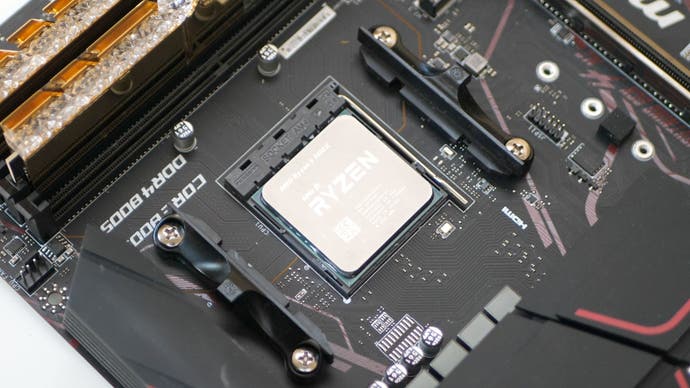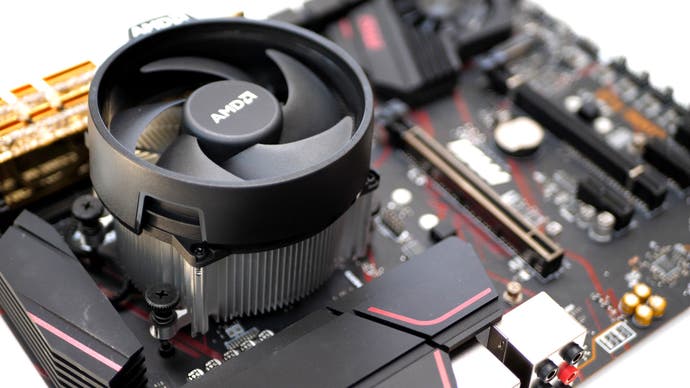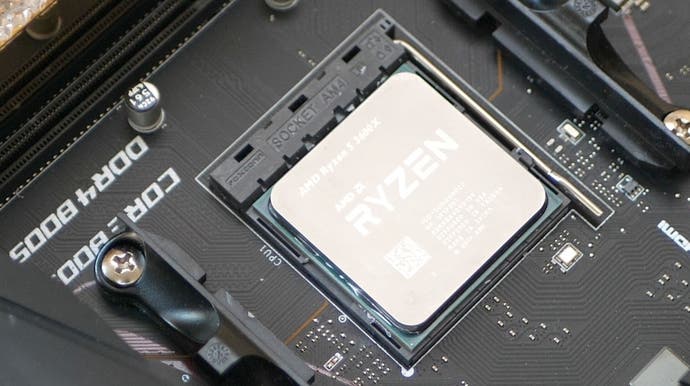AMD Ryzen 5 3600X vs Core i5 9600K review
Which is faster for gaming - and do you really need a more powerful chip?
For years now, the advice for PC gamers pondering a new build has gone something like this: Spend as much as you can on your graphics card, then pick up the cheapest CPU, motherboard and RAM you can find that won't handicap your GPU too badly. For most people, that means picking up a mid-range chip in the $200 to $300 range. The CPU we're testing today falls squarely in the centre of this competitive category: the $249 Ryzen 5 3600X, a six-core, twelve-thread chip based on the 7nm process.
Third-gen Ryzen has proven to be a huge step forward for AMD in our reviews of the $329 Ryzen 7 3700X and $499 Ryzen 9 3900X, so we're expecting a lot here - whether it's Intel or AMD, moving from six cores to an octo-core monster has typically delivered only an incremental rise in gaming performance, so you should be able to save a lot of money here with only a minimal hit to gaming prowess. To see if this theory holds up, we'll be stacking up the Ryzen 5 3600X not only against its immediate competitor - the Core i5 9600K - but also the higher end offerings from both Intel and AMD.
Before we get into the results, it's worth briefly covering what the Ryzen 5 3600X brings to the table. This is a Zen 2 design, like the Ryzen 3700X and 3900X, but this processor includes only one partially-enabled chiplet with six cores and twelve threads enabled out of the eight cores and sixteen threads in the fully-enabled design. That's two cores fewer than the 3700X at the same rated boost clock, so heavily multi-threaded performance - tasks like video rendering or scientific computing - could be noticeably worse but more usual tasks like PC gaming operate with very similar performance levels. You may notice that the 3600X has a higher TDP (95W vs 65W) than the 3700X, making it less power-efficient but potentially minimising the performance differential. You can see the full 3rd-gen Ryzen stack in the table below:

| Ryzen 9 3900X | Ryzen 7 3700X | Ryzen 5 3600X | Core i9 9900K | Core i7 9700K | Core i5 9600K | |
|---|---|---|---|---|---|---|
| Cores/Threads | 12/24 | 8/16 | 6/12 | 8/16 | 8/8 | 6/6 |
| Single-Core Turbo | 4.6GHz | 4.4GHz | 4.4GHz | 5.0GHz | 4.9GHz | 4.6GHz |
| Max All-Core Turbo | 4.1GHz | 4.3GHz | 4.3GHz | 4.7GHz | 4.6GHz | 4.3GHz |
| Cache | 70MB | 36MB | 35MB | 18MB | 14MB | 11MB |
| TDP | 105W | 65W | 95W | 95W | 95W | 95W |
Compared to the previous Zen and Zen+ architectures found in the first and second generation Ryzen designs, Zen 2 makes some pretty big changes. First, the actual processing takes place in chiplets fabricated on a 7nm process, which allows for greater performance while using less power and generating less heat than than previous-gen 12nm designs. I/O is handled on its own die using that older 12nm process, as this is easier to produce and the advantages of 7nm are less impactful here. Despite its plus points, the chiplet design does incur a performance penalty when it comes to memory access times, so AMD has doubled the size of the L3 cache to compensate for this. On a deeper level, Zen 2 also includes a more efficient branch predictor and better AVX instruction handling, a weakness of past Zen architectures. All things considered, AMD promises substantially better single-core and multi-core performance, which should make the 3600X and other third-gen Ryzen designs more competitive in more scenarios than their predecessors.
We could chunter on about micro-architectures all day, but perhaps it's best to move towards the meat and drink of our topic: our actual performance testing. To give a balanced look at the 3600X, we've run this chip against its closest Intel competitor in nearly a dozen recent titles at 1080p, 1440p and 4K.
For this, we used a new Windows 10 installation (with the relevant security and AMD scheduler patches installed) on fast NVMe storage - specifically, the Gigabyte Aorus 2TB NVMe drive provided to us for X570 testing by AMD, which works quite happily on both PCIe 4.0 and PCIe 3.0 expansion slots.
Our primary AMD benchmarking was performed on the entry-level £180 MSI MPG X570 Gaming Plus, with supplementary testing on a high-end motherboard, the £450 Prestige X570 Creation, with both boards loaned to us by MSI. The Gaming Plus is the cheapest MSI option for the X570 platform, with the Creation board targeting overclockers and content creators interested in using multiple PCIe 4.0 devices. As well as stronger power delivery and extreme memory overclocking capabilities up to and beyond 4600MHz, the Creation board includes a full complement of PCIe 4.0 lanes and a bundled PCIe 4.0 add-on card that allows for two extra M.2 drives to be connected in RAID. Meanwhile, second-gen Ryzen was tested on an £380 ASUS ROG Crosshair 8 and the Core processors were tested on an £480 ASUS ROG Maximus XI Extreme.
The Ryzen 3600X and other Ryzen processors were cooled by AMD's Wraith Prism cooler, a slightly better version of the Wraith Spire that comes bundled with the 3600X. On the Intel side of things, a Gaming Storm Castle 240mm AiO was used. Our setup was rounded out with GSkill Trident Z Royal 3600MHz CL16 RAM provided by AMD, a reliable 850W Gaming Storm PSU and an open-air test bench.

Before we get into game testing, it's worth looking at how the 3600X and 9600K compare to each other and their more expensive competitors in content creation - tasks like video rendering, transcoding and more. For this, we opted to use the popular Cinebench R20 application, which replicates a rendering job in industrial-grade video software Cinema 4D.
The results are interesting to say the least, with the Ryzen 5 3600X boasting nearly identical single-core performance to the Ryzen 7 3700X, and only a touch behind the 3900X. The 3600X even beats out the 9600K by a substantial margin and more-or-less equals the 9700K in the single-core run. We see a similar trend in the multi-core results, with the 3600X boasting a 42 per cent increase over the 9600K and nearly equalling the 9700K. However, the higher core counts of the bigger Ryzen processors result in vastly higher scores, suggesting the 3600X is considerably slower when it comes to content creation tasks.
One common task for video producers is transcoding, converting a digital video file from one format into another. A popular choice for this task is Handbrake, and it forms the basis of our next test. Here, a source file is encoded using the Production Standard preset and CRF 18 quality setting using two different encoders - x264 (h.264) and x265 (HEVC) - with the average frame-rate recorded and power usage measured.
The Handbrake results here are in line with the Cinebench scores, with the 3600X being 33 per cent faster than the 9600K in the h.264 test and 25 per cent faster in the HEVC test. However, the 3600X does consume more power to achieve these scores, with a result of 149W measured at the wall compared to 132W for the Intel system - a 13 per cent increase in power usage.
| Ryzen 9 3900X | Ryzen 7 3700X | Ryzen 5 3600X | Ryzen 7 2700X | Core i9 9900K | Core i7 9700K | Core i5 9600K | |
|---|---|---|---|---|---|---|---|
| Cinebench R20 1T | 514 | 494 | 490 | 408 | 520 | 486 | 450 |
| Cinebench R20 MT | 7032 | 4730 | 3705 | 3865 | 5090 | 3759 | 2603 |
| Handbrake h.264 | 51.80fps | 35.05fps | 27.54fps | 27.31fps | 37.87fps | 28.77fps | 20.70fps |
| Handbrake HEVC | 20.29fps | 14.67fps | 11.81fps | 10.04fps | 16.22fps | 13.12fps | 9.46fps |
| HEVC Power Consumption | 228W | 152W | 149W | 224W | 266W | 171W | 132W |
With content creation out of the way, it's time to turn our attention to our real passion and the bulk of this review: gaming performance. After all, Ryzen has always done well in content creation tasks versus their Core counterparts thanks to their higher core and thread counts, but can the advantages of the 7nm Ryzen 3000-series translate into better gaming performance too?
To find out, we sought out repeatable game scenarios to best show the differences between the 3600X and its competitors. Finding these scenes wasn't too much of a challenge - we collectively play a lot of games, after all - but then we needed to capture our test footage to feed them into our bespoke benchmarking system. This is where we ran into some issues, as when you're CPU-limited, any processes running in the background or other hiccups can manifest directly in game in frame drops or stutter, whereas in GPU-limited scenarios these occurrences are normally minimal. Even with a perfect run, different sections of the same scene can show AMD ahead of Intel and vice versa, so it is worth digging deeper into our context-based performance analyses.
We tested each game (with one exception) at 1080p, 1440p and 2160p, using the fastest consumer GPU on the market, the RTX 2080 Ti. The 1080p benchmarks ought to be useful for anyone considering a high refresh rate monitor, but this is the most CPU-limited scenario so stutter is more likely. 1440p is the current sweet spot for resolution versus frame-rate, where a mid-range to high-end system can achieve 60 to 120fps in most titles and CPU-induced stutter is ameliorated. Finally, 4K is the least CPU-bound and generally most balanced scenario, but some games still exhibit small differences between different processors so it's worth seeing the results.
AMD Ryzen 5 3600X analysis
- Introduction, hardware breakdown, test system [This Page]
- Gaming benchmarks: Assassin's Creed Odyssey, Battlefield 5, Far Cry 5
- Gaming benchmarks: Crysis 3, Metro Exodus, Kingdom Come Deliverance, The Witcher 3
- Gaming benchmarks: Ryzen vs Core - memory bandwidth analysis
- Ryzen 5 3600X: the Digital Foundry verdict

